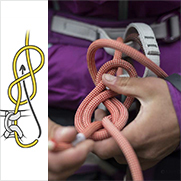Coworker rescue: planning ahead means a rapid response
Any incident that occurs when working at height can worsen if the worker, now injured, is not quickly lowered to the ground or to a sheltered area that is easy for emergency responders to reach.
June 25 2016
This especially applies to any victim who remains suspended and unconscious in their harness; they must be rescued immediately since the onset of physiological symptoms from hanging motionless in a harness can appear in just a few minutes.
This is why workers must plan and establish ahead of time the means for conducting a quick rescue in the event of an incident at work. Depending on the work situation, it is possible to set up several different rescue strategies, from a preinstalled evacuation kit to being rescued by a coworker..
Most rescue situations follow the same critical steps:
1 - Accessing the victim,
2 - Releasing the victim from the structure,
3 - Evacuating the victim to lower them to the ground (a tandem descent or lowering them with a device).
View the general principles for an effective rescue
Releasing the victim
Once the rescuer reaches the victim, the first issue to resolve is releasing them from the structure. You need to raise the victim to be able to unclip the carabiner that connects them to the structure from which they are hanging.
Releasing with a fall-arrest lanyard
For the most common cases when using a fall-arrest system at work, a pre-rigged rescue kit available at the site facilitates conducting the maneuver. The rescuer-coworker will only need to use the equipment contained in the rescue kit.
View the corresponding rescue techniques in detail
Release technique for rope access work
For rope access work, releasing the victim can be much more complicated due to the elasticity of the support system. The rescuer-teammate should be able to conduct rescue maneuvers using the dedicated rescue kit at the work site as well as personal gear if needed.
View the corresponding rescue techniques in detail
Solution to avoid having to reach and realease the victim: working with a releasable anchor
To avoid having to reach and release the victim, the solution consists of setting up a releasable anchor for the workstation.
This technique allows the person on the ground to be able to directly intervene in the event of an emergency, even without a harness. It simply requires releasing the system to lower the victim to the ground.
View the corresponding rescue techniques in detail
Rescuing a coworker using standard rope access equipment
Rope access workers are trained in rescuing a coworker by applying techniques that employ the standard equipment they use on the job. Mastering these techniques requires understanding the limits of their equipment to avoid endangering the rescuer + victim.
- Capacity and limits of the I’D S for a tandem descent
- Capacity and limits of the ASAP for a tandem descent
View all worksite rescue tech tips

Related News








